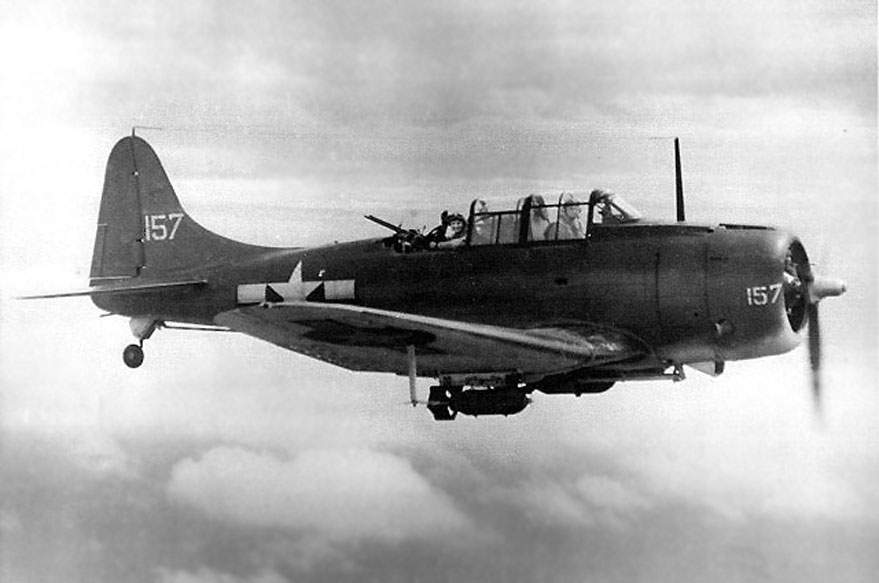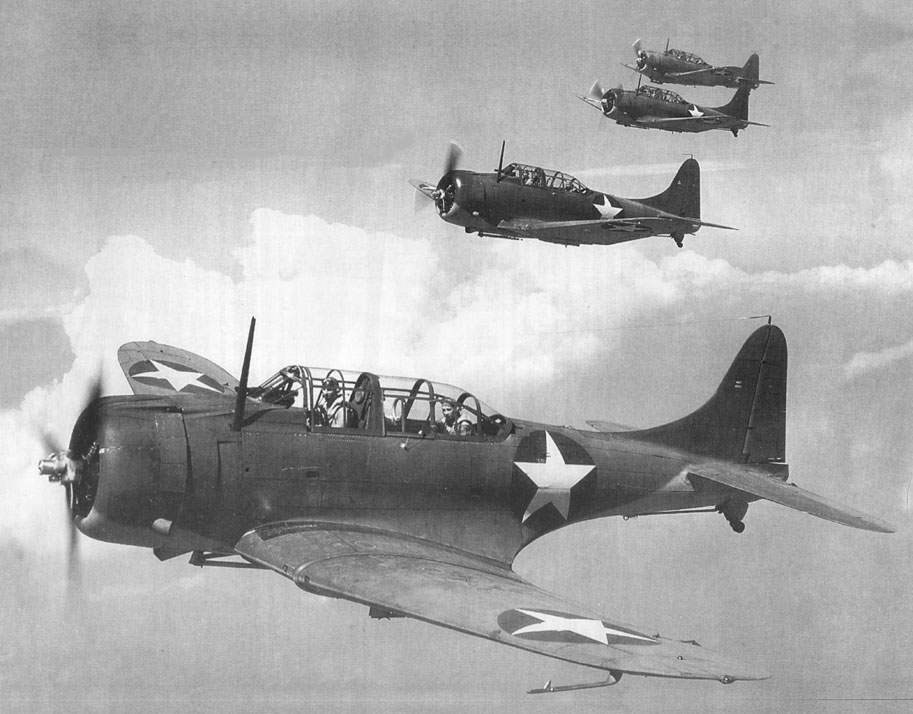|
A-24/SBD Dauntless. Combat Use.
All US Marine Corps Dauntless were destroyed on the ground in the attack on Pearl Harbor on December 7, 1941. During the Battle of the Coral Sea on May 7, 1942, the airwaves were jammed with radio transmissions, and anxious crew members aboard the US aircraft carriers "Lexington" and "Yorktown" did not know about the course of the battle, until a clear voice broke through: "One aircraft carrier destroyed! Dixon - aircraft carrier. One aircraft carrier destroyed! Lieutenant Commander Robert E. Dickson, commander of VB-2, reported the sinking of the Japanese aircraft carrier Shoho with 545 crew members after a 30-minute battle at the cost of only three American aircraft - a triumph for the SBD-2 and SBD-3 models Dauntless, only surpassed in the pivotal Battle of Midway Atoll a few weeks later.
An air group aboard a typical American Navy aircraft carrier usually included two squadrons of fighters (F4F Wildcat or later F6F Hellcat), one squadron of TBD Devastator torpedo bombers, later TBF Avenger) and two "Dauntless" squadrons, one for bombing and one for reconnaissance. They were designated VB and VS squadrons respectively. The reconnaissance missions were planned before it became clear that the American aircraft carriers would have the radar protection that had been available since the beginning of the conflict, while the Japanese aircraft carriers had not. There was practically no difference in training - the reconnaissance pilots of the VS squadron trained in dive bombing in the same way as their counterparts from the VB squadron.
The dive bomber turned the tide of the war in the battle of Midway Atoll on June 4, 1942. The reasons for this success are not obvious to specialists: the aircraft had a low thrust-to-weight ratio, providing only more or less satisfactory rates of climb and maneuverability; the weapons system was malfunctioning, and from time to time a 227 kg ventral bomb fell uselessly into the sea.
Launching from Admiral Chester Nimitz's carrier groups to search for Admiral Yamamoto's aircraft carriers, they ran out of fuel and reached the limits of range and autonomy at dusk when they finally ran into and attacked the enemy fleet. Lieutenant Commander C. Wade McClusky, Commander (Captain 3rd Rank) Max Leslie and other Dauntless pilots from VS-5 and VB-3 squadrons from the aircraft carrier Yorktown, VS-6 and VB-6s from the aircraft carrier Enterprise, VS-8s and VB-8s from the aircraft carrier Hornet lost 40 of 128 dive bombers.
Diving from the side of the setting sun, sending the Japanese aircraft carriers Kara (Kaga), Akagi (Akagi), Hiryu (Hiryu) and Soryu (Soryu) to the seabed, they completely changed the course of the war in the Pacific. Few other types of aircraft (perhaps only the Spitfire and the Hurricane) can claim to have changed history as much as the Dauntless dive bomber.
At the end of the war, the Dauntless was superseded as a dive bomber by the more modern SB2C Heldiver, but the latter, not very successful aircraft, could not achieve the same recognition as the Douglas machine. "Dauntless" began to be involved in less prestigious anti-submarine patrol work and close air support tasks. The SBD has also served with at least 20 squadrons of the United States Marine Corps. Many hundreds of SBDs were retrofitted with the Westinghouse ASB radar, the first radar used by the US Navy.
While flying the Dauntless, pilots found it strict in handling the machine, which had an unfortunate tendency to quickly lose speed on tight turns. In dive bombing flights, the pilot approached the target at an altitude of 4500-6000 m, took up a position almost directly above it. pulled its nose, released the upper and lower brake flaps and "fell", accelerating less quickly than you would expect in a steep fall with an angle of more than 70 degrees. Using the Mk.VIH red dot sight, which, starting from SBD-5. replaced the former telescopic sight (which tended to fog up in a dive as a result of temperature changes), the pilot aimed by literally pointing the aircraft at the target. The bomb was dropped by a red button on the aircraft control stick, marked with the letter "B". Resetting the combat load was carried out separately or in one gulp.
According to the legend that existed in the US Navy, the pilots of this aircraft were subjected to "hypnosis" of the target, which drew them into the continuation of the dive and prevented the timely exit from it. After dropping the bombs, the aircraft was easily brought out of the dive with a slight movement of the control stick. In general, the machine handled well in normal flight. The pilot's visibility was excellent both in the horizon and when descending to land on an aircraft carrier. Few aircraft were stronger or more reliable; The Dauntless often returned with heavy combat damage.
In the US Air Force, "Dauntless" was not immediately liked by everyone. In January 1941, the US Air Force placed an order for 78 A-24s similar to the US Navy SBD-3s, but without carrier landing equipment. In addition, 90 SBD-3s from the US Navy contract were modified for ground-based conditions and delivered to the US Air Force as SBD-3A (A - for the army). Ultimately, the US Air Force ordered 100 A-24A identical to the SBD-4 and 615 A-24B equivalent to the SBD-5 but built at the Douglas factory in Tulsa.
A-24s were in service with the 27th Bomber Group in New Guinea and with the 531st Fighter-Bomber Squadron at Makin. It turned out that the US Air Force pilots could not outmanoeuvre the aggressive Japanese fighters. While the U.S. Navy radio gunners were highly effective (one U.S. Navy crew shot down seven Mitsubishi Zero fighters in two days), the A-24's performance was weaker. Losses reached such a level that this type was no longer used on the land front. Since the US Navy pilots in the battles in the Coral Sea and Midway Atoll demonstrated the ability to stand up for themselves against the Zero, the unsatisfactory performance of the Dauntless in the US Air Force is usually explained by the inexperience of the Air Force crews and their low morale.
In July 1943, 25 Squadron New Zealand Air Force received 18 SBD-3s from the US Marine Corps. Later, having received 27 SBD-4s and 23 SBD-5s, the New Zealand Air Force squadron fought in Bougainville. Another foreign user of the Dauntless was France, which in the autumn of 1944 armed two units of the Free French Navy - flotillas 3B and 4B - in Agadir, Morocco - with A-24 and SBD-3 aircraft. "Dauntless" participated in the battles in France against the retreating German troops and further - until victory in Europe. Although production ended on 22 July 1944, French SBDs were used at the Meknes fighter school until 1953.
The UK received nine SBD-5s under the designation "Dauntless" DB.Mk.I. By this time, in 1944, it was rated as low power and slow. British pilots also found the Dauntless tiresome and noisy. No consensus could be reached on the type's vulnerability to fighters: the Pacific War showed it was not very vulnerable, but RAF test pilots believed it was not. British vehicles have been extensively researched, but the Dauntless's time for service in the UK army has already passed. In the United States, where the A-24 was redesignated F-24 in 1947, the QF-24A unmanned aerial vehicle and QF-24B command and control aircraft were used (both rebuilt with serial numbers in 1948). "Dauntless" remained in service until 1950.
Several A-24B "Dauntless" ended up in the Mexican Air Force after the war, which was apparently the last user of this type, having them in service until 1959.
A total of 5936 Dauntless aircraft of all variants were produced.
 |
Drawing SBD-3
|
 |
1/Lt. James "Ike" Eikner Jr. and gunner, Sgt. Frank Sparks on a Rabaul strike mission. Courtesy: Bill Eikner (Brother).
|
 |
The SBD-3 in training flight at 1942 - 1943
|
Bibliography

- "Encyclopedia of military engineering" /Aerospace Publising/
- "American warplanes of World War II" /under cor. David Donald/
- "aviAMaster" /#7, 8 Grigoriy Minskiy/
|






